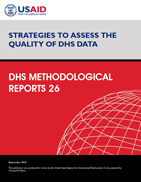
Abstract:
The Demographic and Health Surveys (DHS)
Program strives to maintain the highest
standards of data collection, processing, and
analysis. This report is one of a series of
DHS Methodological Reports on data quality.
Earlier reports included descriptions of
methods but focused on actual assessments of,
for example, maternal mortality data or
potential interview effects. This report
focuses primarily on strategies and new
methods, or significant modifications of
methods that have appeared previously. The
report includes many examples for
illustrative purposes. The methods can be
generalized to other substantive outcomes.
For example, a chapter on the analysis of
fertility that uses retrospective birth
histories could be extended to under-5
mortality using the birth histories, or to
adult and maternal mortality using the
retrospective sibling histories.
The report has five main chapters. After the
introductory chapter, Chapter 2 focuses on a
type of displacement of birthdate, observed
in many DHS surveys, that results from
recording the year of birth as the year of
interview minus years of age. The calculation
is correct only if the respondent has already
reached their birthday in the year of
interview. Displacement of month of birth has
been noted in the past but without an
explanation of the mechanism behind it.
Chapter 2 describes a simple indicator to
measure the resulting bias, as well as other
indicators based on the stated month of
birth, and for children, the day of birth.
Chapter 3 focuses on the quality of the birth
histories. The main method is a comparison of
two successive surveys and their estimates of
fertility rates for the 5 calendar years
before the first survey. Single-year rates,
as well as 5-year rates, are compared with
statistical models. Chapter 4 uses
statistical models to describe variations in
data quality indicators according to
characteristics such as place of residence,
household wealth, and level of education.
Quality-related outcomes, such as nonresponse
or age heaping, may potentially vary for
reasons that lie beyond the implementation of
fieldwork. It could be argued that
interviewer effects, for example, should be
adjusted for the characteristics of the
individuals being interviewed.
Chapter 5 discusses the interview process
and, in particular, the duration of the
household interview, as related to its
position within the duration of fieldwork,
within the duration of fieldwork in a
specific cluster or time of day, and how the
duration of the interview relates to the
number of household members and the number of
items in the questionnaire. In the same way
as age heaping, very short interviews may
suggest substantively serious data quality
problems. Chapter 6 provides examples of how
it is possible to focus on interviewers,
clusters, and days, in any combination, in
which there was an irregularity that was both
large in magnitude and statistically
significant. It is possible to simulate or
track the fieldwork in a variety of ways by
using information from the data files.
The methods described here, as well as those
that appeared earlier, will be used in the
future to prepare data quality profiles of
all DHS surveys, and to better monitor long-
term trends in data quality and identify
potential problems in new surveys. Some
methods can also be adapted to better monitor
data quality in real time during fieldwork.
